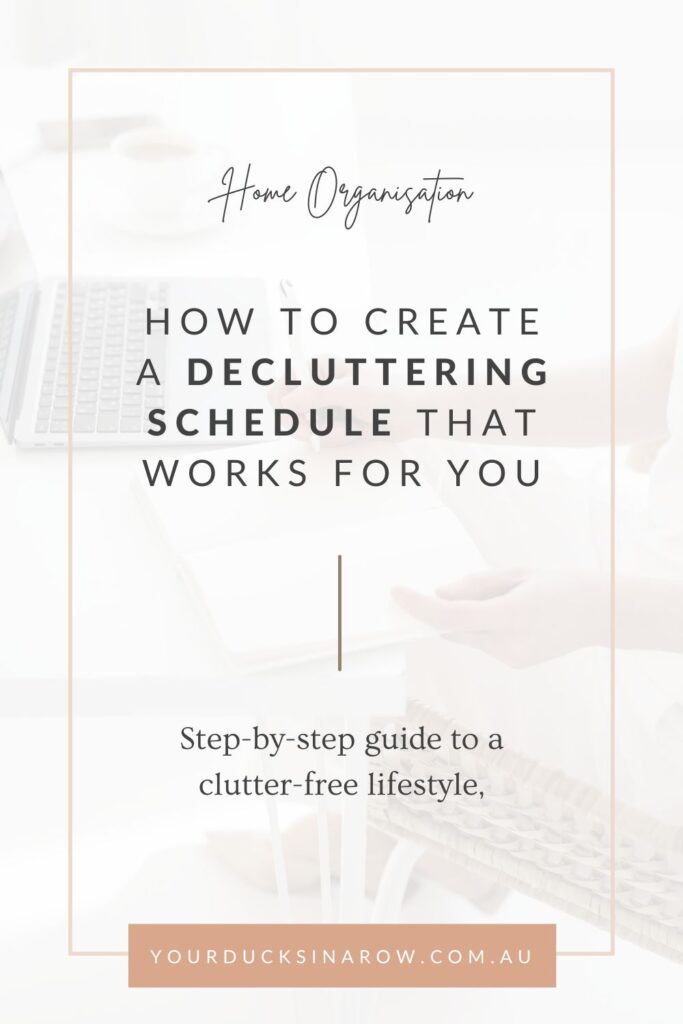Make Consistent Progress Without Feeling Overwhelmed with a Decluttering Schedule That Works For You
Decluttering your entire home can feel like a massive task, especially if you’re balancing work, kids, and the general busyness of life. But here’s the good news: you don’t need to tackle it all in one weekend. The key to long-term success is consistency, and that starts with a decluttering schedule that actually fits your lifestyle.
In this blog, we’ll walk you through how to create a personalised, flexible decluttering routine that keeps your home organised, tidy, and manageable, without burning out or giving up halfway through.

Why You Need a Decluttering Schedule
Let’s start with the “why.” Decluttering isn’t just a one-time event. Just like laundry and dishes, clutter tends to creep back in. A schedule gives you structure and direction, helping you make steady progress instead of falling into the all-or-nothing trap.
Whether you’re working toward a minimalist home or simply trying to clear the chaos, having a realistic routine helps you:
- Avoid feeling overwhelmed by the big picture
- Stay on track even during busy weeks
- Build decluttering into your weekly habits, not just a chore
- Maintain your newly organised spaces long-term after the initial clean-up
Step 1: Start with Your Goals
Before you start creating your decluttering schedule, get clear on your why.
Ask yourself: What’s your reason for decluttering right now? Your motivation is your anchor, it will keep you going when momentum slows.
Some common reasons include:
- Preparing for a move and needing to downsize
- Craving a calmer, more functional living space
- Tired of the daily stress and visual chaos of clutter
- Wanting to create a more organised home for your family
Knowing your motivation will help guide your timeline and keep you focused when motivation dips. No goal is too small. Clarity here will help shape your schedule and guide your priorities.
Step 2: Assess Your Time and Energy
Not everyone has hours to spare each day, and that’s okay. Your schedule needs to fit your life, not the other way around.
Be honest about how much time you can realistically dedicate:
- 5 minutes per day: Try a daily declutter challenge. Tackle tiny areas like a junk drawer, makeup bag, or bedside table.
- 30 minutes, 3x per week: Pick a room or category to chip away at over the week. This approach is perfect for working through one room or category gradually.
- Half-day on weekends: Great for deeper dives into bigger areas like the garage, wardrobes or pantry.
Pro Tip: Consistency matters more than intensity. Small, regular efforts add up faster than you think. Momentum builds quickly once you start seeing progress.
Step 3: Break It Down by Room or Category
Next, map out your home into manageable zones or categories. It’s time to get strategic, because trying to declutter your whole home in one go is chaotic. Instead, divide your home into manageable chunks. This makes the job less overwhelming and helps you see tangible progress.
Try one of these methods:
- By room: Bedroom, bathroom, kitchen, laundry, garage, etc.
- By category (Marie Kondo-style): Clothes, books, paperwork, sentimental items.
- By function: Daily-use zones vs. long-term storage areas.
Once you’ve made your list, assign a timeframe to each. Keep it flexible, you can always adjust as you go and learn what works best for your pace.
Step 4: Build Your Weekly Decluttering Plan
Once you’ve identified your zones or categories, now it’s time to plug it into your calendar. Think of it like a workout plan, but for your space.
Example Weekly Plan:
- Monday: 10-minute tidy in the entryway (shoes, keys, mail)
- Wednesday: Sort one kitchen drawer or shelf
- Saturday: 1-hour wardrobe edit, seasonal swap or donation pile
- Sunday: Drop off donations, tidy up + refresh any clutter hotspots
Don’t overload yourself. It’s better to do a little consistently than plan too much and burn out.
Pro Tip: Pair decluttering with your daily routine or existing habits. Do a quick 5-minute tidy while waiting for the kettle to boil or sort a drawer while on a phone call or tidy up a shelf while waiting for dinner to cook.
Step 5: Use Tools to Stay Accountable
You don’t have to do this alone. A few tricks to help you stick with it:
We all get sidetracked. You don’t have to do this alone. Luckily, a few tricks, handy tools and techniques can help you stick with it and even make it fun.
Try these:
- Set phone reminders or recurring calendar alerts
- Use a printable or digital checklist to track progress
- Take before-and-after photos to track your progress and for that “wow” factor
- Get the family involved (especially with toys, laundry, and shared spaces), kids love mini challenges and sticker rewards!
- Join an online decluttering group or challenge for motivation and accountability
Follow us on Instagram for daily, weekly, or monthly mini challenges, practical tips, and a whole lot of fun!
Step 6: Don’t Skip Maintenance Days
Once you’ve made progress, protect your hard work with short maintenance sessions. These short, regular resets prevent backsliding into chaos. Schedule regular “reset” times to:
- Return items to their proper places
- Reassess spaces that are getting cluttered again
- Donate anything you no longer need
Even just 15–20 minutes per week can keep your home from sliding back into chaos and can make a big difference!
Step 7: Adjust As You Go
Your decluttering schedule should work for you, not against you. Life changes, so your routine should be flexible too.
If a system isn’t working, tweak it. Here’s how to pivot without losing momentum:
- Shift from room-based to category-based if you’re stuck
- Scale back during busy weeks (and pick back up when ready)
- Ask for help with tougher tasks (hello, garage!)
- Celebrate the wins, even small ones like clearing a shelf or emptying a box, instead of focusing on what’s left to do
Always remember, Progress over Perfection, The goal is steady, realistic progress!
Decluttering and Home Organising Go Hand in Hand
Remember: Decluttering is about deciding what stays or goes, it’s the first step! Home organising is what you do with the items you’re keeping. Once you’ve cleared out the unnecessary, or decluttered a space, take a little extra time to set up simple, labelled systems that are easy to maintain. This makes your home more functional, peaceful, and clutter-free in the long run.
Think:
- Labelled bins
- Drawer dividers
- Grouping like items together
A bit of thoughtful organisation makes your home more peaceful, functional, and clutter-free for the long haul.
Creating a decluttering schedule doesn’t have to be complicated or strict. It just needs to match your goals, your time, and your lifestyle. Start small. Stay consistent. Tweaks as needed. And celebrate each space and every corner of your home you reclaim.
You’ve got this, and we’re here to help your on every step of the way.
Need help getting started?
Sometimes a little support goes a long way. Book a consultation with one of our friendly, professional home organisers to have some one on one hands-on help that’s tailored to you and your space.


